|
Where on Earth? Answer Archive
To submit an answer to the current Where
on Earth? click
here.
To offer photographs for Where
on Earth? send an E-mail message to earth@earthmagazine.org.
2000:
January February March
April
May
June
July
August
September
October
November
December
2001:
January
February
March
April
May
June
July
August
September
October
November
December
2002:
January
February
March
April
May
June
July
August
September
October
November
December
2003:
January
February
March
April
May
June
July
August
September
October
November
December
2004:
January
February
March
April
May
June
July
August
September
October
November
December
2005:
January
February
March
April
May
June
July
August
September
October
November
December
2006:
January
February
March
April
May
June
July
August
September
October
November
December
2007:
January
February
March
April
May
June
July
August
September
October
November
December
2008:
January
February
March
April
May
June
July
August
December 2001
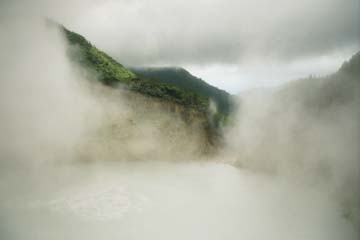 |
Clues:
1. This flooded fumarole sits in a 17,000-acre park named for a subset of the five volcanic peaks found within its boundaries. 2. The local inhabitants share their name with a religious order and a republic. 3. An adjacent
island experienced the largest number of casualties from a voalcanis eruption
in the 20th century. Name the feature and its location. Scroll down for the answer
|
| Answer: Boiling Lake in the Morne Trois Pitons National Park in the Commonwealth of Dominica. Photo taken by Christina Reed. |
December 2001 winners:
1. Robin Bartel (Midland, TX)
2. Alejandro J. Benavides (Elko, NV)
3. Morgan Button (Cincinnati, OH)
4. Jerry D. Dolence (Reno, NV)
5. Fred A. Guthrie (Crossville, TN)
6. Lura Joseph (Mahomet, IL)
7. Dorothy Lewis (Milton, FL)
8. Janice Sellers (El Cerrito, CA)
9. Jim Shelden
10. Peter Stauffer (Menlo Park, CA)
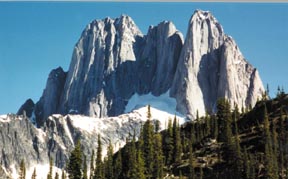 |
Clues:
1. These awesome peaks, which top off at just under 3,400 meters, are the eroded remains of an Early Cretaceous granite (quartz monzonite) batholith that intruded Middle Proterozoic slate, phyllit and schist. 2. Despite the name of the park where these peaks are located, there is nothing imaginary about the fear even world-class climbers have felt in their ascents here. 3. The gateway city to this
locality hosted the Winter Olympics a few years ago. Name the formation and its location. Scroll down for the answer
... |
| Answer: Howser Spires, Bugaboo Provincial Park, Purcell Mountains, British Columbia, Canada. Photo courtesy of Wallace R. Hansen. |
November 2001 winners:
1. Bill Albright (Reno, NV)
2. Paul Friberg (New Paltz, NY)
3. Dean Hancock (Denver, CO)
4. Rick Moscati
5. Sandra Stapp (Oceanside, CA)
6. Chris Breemer (Portland, OR)
7. Tom Hilbert (Rockford, IL)
8. Darla Heil (Bishop, CA)
9. Anthony Qamar (Seattle, WA)
10. Robert McBride (Lititz, PA)
Runners Up
Chuck Cofer (Houston, TX)
Ronald Crawford (Port Angeles, WA)
John I. Garver (Schenectady, NY)
Doug Geller (Portland, OR)
David Rees Gillette (Golden, CO)
Tom Kalakay (Bozeman, MT)
Mauri S. Pelto (Dudley, MA)
Robert Stolzenbach (Lakeside, MT)
David E. Thompson (Clinton, MS)
Dave Van Dillen
October 2001
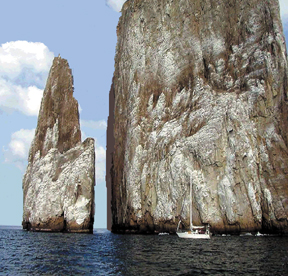 |
Clues:
1. The local Spanish name given to this vertical tuff cone, which abruptly rises almost 500 feet from the ocean, means "lion at rest." Explorer james Colnett gave the spot its more widely used English name. 2. The rock is located on an island that is composed of two coalesced volcanoes. On the southwestern side lies a symmetrical shield volcano buried by a weather-beaten pyroclastic cover. The second volcano sits on the northeastern side, and its lava flows are only a few centuries old. 3. The island
chain in which this structure is found is best known for its biological
significance. TheUnited Nations declared the chain a Natural Patrimony
of Humanity in 1979 and a Reserve of the Biosphere in 1985. Name the island. Scroll down for the answer
... |
| Answer: Kicker Rock or Leon Dormido is the tuff cone. The island is San Cristobal in the Galapagos. Photo by Suzette Connely and supplied by Emilie Lorditch of Inside Science. |
October 2001 winners:
1. Theresa Schlosser (East Meadow, NY)
2. Dennis Geist (Moscow, ID)
3. Fred A. Guthrie (Crossville, TN)
4. Jack Berkley (Fredonia, NY)
5. Rene De Hon (Monroe, LA)
6. Daniel Laó Dávila (Miami, FL)
7. George Daily (Dallas, TX)
8. Eagle C. Tovar, Jr. (Enumclaw, WA)
9. J. Brad Stephenson (Oak Ridge, TN)
10. Vicen Carrió (Edinburgh, Scotland)
Runners Up
Anne Argast (Fort Wayne, IN)
Wally R. Hansen (Lakewood, CO)
Ken Long (New Wilmington, PA)
Jamie Martin-McNaughton (Providence, RI)
Alexander McBirney (Eugene, OR)
Rob McDowell (Atlanta, GA)
Brian Moniz (N. Hollywood, CA)
Bill Romey (East Orleans, MA)
Bart A. Weis (Denver, CO)
September 2001
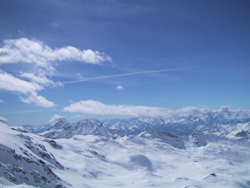 |
Clues:
1. Ski slopes sweep down on either side of this spot, but bring your passport. A national border runs across the top of this ridge. 2. Behind the photographer towers a famous peak whose top is an example of an isolated rock unit that is an erosional remnant of a nappe. 3. One of this mountain's glaciers
feeds the headwaters of a river that flows through the region made popular
by author Peter Mayle. Name the peak referred to in clue #2, or one of the two towns that sit on either side of this vantage point. Scroll down for the answer
... |
| Answer: The Matterhorn is the peak. The two towns are Zermatt, Switzerland, and Il Cervino, Italy. Photo by Shane Naughton. |
September 2001 winners:
1. George Pafumi (Schenectady, NY)
2. Leslie Anne Morgan (Fairfield, CA)
3. Joe Donoghue (Tallahassee, FL)
4. Francis Hansen (Satellite Beach, FL)
5. Elizabeth Owosina (Myers, FL)
6. Stan Frazier (Murfreesboro, TN)
7. Alan R. Haight (Sunriver, OR)
8. J.T. (Han) van Gorsel (Houston, TX)
9. Charles Burnham (Durango, CO)
10. J. Marc Coolen (Hager Hill, KY)
September 2001 runners-up
William L. Smith (McLean, VA)
Paul A. Tanner (Manchester, CT)
Celia M. Adams (Pasadena, MD)
G. Steven Ferris (Lincoln, NE)
Jane Selverstone (Albuquerque, NM)
Mauri Pelto (Dudley, MA)
Fred A. Guthrie (Crossville, TN)
Bruce R. Johnson (Reston, VA)
Jesse G. White (Moscow, ID)
John Friess (Lubbock, TX)
Kyle Gay (Apple Valley, CA)
David Schmidt (Dayton, OH)
Mike Knoepfle (Schaumburg, IL)
Mack Duncan (Thomson, GA)
Sandra Stapp (Oceanside, CA)
August 2001
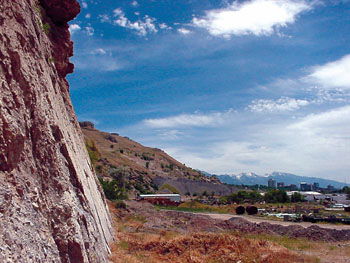 |
Clues:
1. This spectacular fault scarp is partially covered by a tufa layer deposited when the site was covered by a glacial lake. 2. The legendary geologist who first described this fault concluded that its geometry was representative of an entire class of structures. 3. The city in the distance is an important religious center. Scroll down for the answer
... |
| Answer: Warm Springs fault scarp north of Salt Lake City, Utah. Photo by David Applegate with thanks to Miles Unlimited and David Dinter. |
August 2001 winners:
Ryan D. Christensen (DeKalb, IL)
Bill Dixon (Naperville, IL)
Rob McDowell (Atlanta, GA)
Geoff Rawling (Socorro, NM)
Morgan Button (Cincinnati, OH)
Mack Duncan (Wrens, GA)
Jim Humphrey (Midland, TX)
Bill Thomas (Plano, TX)
Charles W. Sprague (Dallas, TX)
Anson Mark (Lakewood, CO)
Runners up:
Keith T. Anderson (Converse, TX)
James Baer (Provo, UT)
Doug Bedingfield
Roger L. Burtner (Fullerton, CA)
Doug Curl (Lexington, KY)
Kelly Dilliard (Evansville, IN)
Steven I. Dutch (Green Bay, WI)
Michelle Fleck (Price, UT)
Richard B. Furner (Dallas, TX)
Julia Grim (California)
Larry Guth (Fitchburg, MA)
Fred Guthrie (Crossville, TN)
Craig Hall (Katy, TX)
Tom Hawisher (Savoy, IL)
Brad Hill (Centerville, UT)
James Hinthorne (Ellensburg, WA)
Lillian Kearney (Houston, TX)
Ralph Langenheim, Jr. (Urbana, IL)
Jack Long (Fort Collins, CO)
Bill Lund (Cedar City, UT)
Terry Naumann (Anchorage, AK)
Dru R. Nielson (Walnut Creek, CA)
Ertan Peksen (Salt Lake City, UT)
Sid Perkins (on behalf of the 2nd flr. Science
writers at Science News, Alexandria, VA)
Brian Peterson (Petoskey, MI)
M. Dane Picard (Salt Lake City, UT)
Anna Robbins
David Schmidt (Oakwood, OH)
Richard P. Smith (Idaho Falls, ID)
Derek Steadman (Thatcher, ID)
J. Brad Stephenson (Oak Ridge, TN)
Mike Stevenson (Price, UT)
John P. Stimac (Charleston, IL)
Rich Ugland
David E. Wilkins (Boise, ID)
Michael Winter (Woodland Hills, CA)
Cecile Zachary (Manhattan, KS)
Pamela B. Zohar (Elko, NV)
July 2001
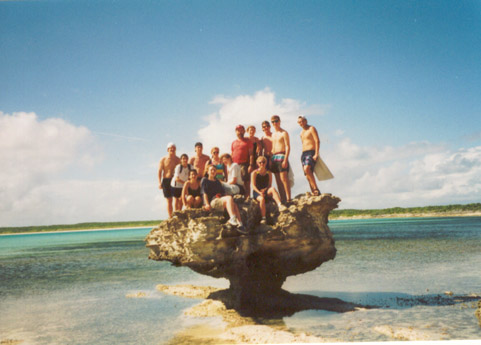 |
Clues:
1. This island was originally called Geanahani by the native Lucayan people. At one time the island was named after buccaneer George Watling but today is known by the name its first Italian visitor gave it. 2. The subaerial carbonates pictured here were probably deposited by shoaling during stormy periods when sediments blanketed a carbonate platform and progressively emerged into beach ridges and dunes. 3. During the lowstands of the Quaternary, differential weathering formed this structure. At the same time, rainwater dissolved blue holes and caves throughout the island, which is locally called a cay. Scroll down for the answer
... |
| Answer: San Salvador island in the Bahamas. Photo and clues provided by Mary Jo Alfano. |
July 2001 winners:
Roy C. Kepferle (Cincinnati, OH)
James Conder (St. Louis, MO)
Andy Armstrong (Kalamazoo, MI)
William Lee Smith (McLean, VA)
Celia M. Adams (Pasadena, MD)
Ralph Langenheim, Jr. (Urbana, IL)
Holly Kelly (Centerville, OH)
Ron Kaufmann (Miami, FL)
Elizabeth Owosina (Fort Myers, FL)
Jim Humphrey (Midland, TX)
Runners up:
Sandra Stapp (Oceanside, CA)
Jim Sukup (Carmel, IN)
Peter Heitzmann (Dale City, VA)
R. Coveney (Kansas City, MO)
Timothy Flanagan
Carl Froede, Jr.
Sid Perkins (Alexandria, VA)
David R. Wunsch (Concord, NH)
Aaron Phillips
Kerry Szemple (Bayonne, NJ)
Rob McDowell
Brian Milliman (Averill Park, NY)
Russell Kennedy (Gaithersburg, MD)
Jerry Dolence (Reno, NV)
Charles W. Sprague (Dallas, TX)
Bill Thomas (Plano, TX)
R. D. (Bob) Benson (Golden, CO)
Chris Scott (Brentwood, TN)
J. Brad Stephenson (Oak Ridge, TN)
Bart Weis (Aurora, CO)
Jennie Coe (Stamford, CT)
Allen V. Shaw (Bethesda, MD)
J. Thomas Parr
Andrew Alden
Frank Swit
Matt Crawford
Edith Chasen
Jennifer S. Prouty (Corpus Christi, TX)
David W. Steadman (Gainesville, FL)
Joe Donoghue (Tallahassee, FL)
Jesse MIller (Syracuse, NY)
Barb McGavern-Atkinson
Jacq Marie Jack
June 2001 clues & answer:
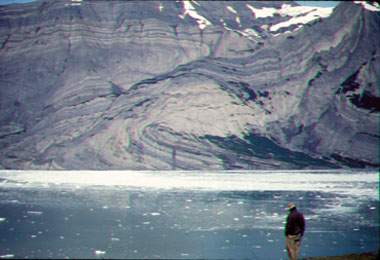 |
Clues:
1. The fold and formation shown here are named after a nearby fishing and logging town. 2. Just out of the picture to the left, a glacier hits tidewater. The glacier was named after the first professor of geology at Princeton University -- a man who has also had three mountains, one crater on the Moon and a hall on the Princeton campus named in his honor. 3. While the amount of deformation might suggest otherwise, these rocks are relatively young (Pliocene to Pleistocene). Scroll down for the answer
... |
| Answer: Guyot Hills, adjacent to the Guyot Glacier in Icy Bay, Alaska. Photo and clues provided by Scott Broadwell. |
June 2001 winners:
Ken Van Dellen (Grosse Pointe Park, MI)
Peter Heitzmann (Dale City, VA)
Ruth Jewell (Kettering, OH)
Jim Sukup (Carmel, IN)
Becky Ciske (Villa Park, IL)
Jessica Gorman (Washington, DC)
Michael A. Siemens (Rolla, MO)
Bill Frechette (Acworth, GA)
Christie M. ODay (Tempe, AZ)
Brian W. Collins (Missoula, MT)
May 2001 clues & answer:
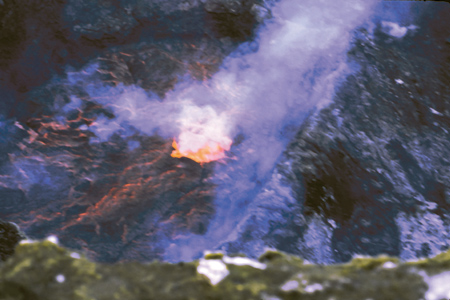 |
Clues:
1. This 3,800m-high, active volcano was first described by a famous British explorer in 1841, but was not climbed until 1908 (by a group led by a famous Irish explorer). 2. The volcano is situated on an island and produces an unusual phonolitic lava containing up to 12 cm-long anorthoclase crystals. 3. The inner crater hosts a persistent convecting lava lake that frequently showers the crater and upper slopes with bombs. Scroll down for the answer
... |
| Answer: Mount Erebus stands at 3,794 feet on Ross Island in Antarctica. It was discovered by James Ross and first climbed by Ernest Shackleton and crew. Photo and clues from Rick Aster, Phil Kyle, and Bill McIntosh of New Mexico Tech. |
May 2001 winners:
Peter Heitzmann (Dale City, VA)
Edward Grew (Orono, ME)
Susan Milius (Washington, DC)
Rob McDowell (Atlanta, GA)
Nelson Andrekovic (Wickliffe, OH)
Sandra Stapp (Oceanside, CA)
Ruth Jewell (Kettering, OH)
Tom Parr (Reading, MA)
Matthew B. Morris (Pittsburgh, PA)
Dan Miggins (Denver, CO)
April 2001 clues & answer:
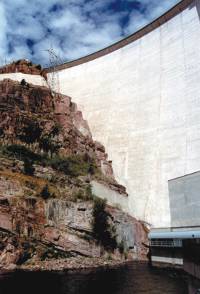 |
Clues:
1. The rocks pictured are part of a four-mile thick Precambrian sedimentary sequence. (The dam is more recent.) 2. The strike of the adjacent mountains is orthogonal to that of surrounding ranges, reflecting a more ancient tectonic history. 3. The location's name comes from a vivid description by a famous one-armed explorer. Scroll down for the answer ... |
| Answer: The Flaming Gorge Dam is located in the northeast corner of Utah at the eastern end of the Uinta Mountains. Photo by David Applegate. |
April 2001 winners:
Mack Duncan - Wrens, Ga.
Mauri Pelto - Dudley, Mass.
Beth McMillian - Laramie, Wyo.
Sandra Stapp - Oceanside, Calif.
Gary Millhollen - Hays, Kan.
Charles Chapman - Ridgefield, Conn.
Fred Hawkins - Colo.
Rob Fillmore - Gunnison, Colo.
Garry Zabel - Glenwood Springs, Colo.
Steve Spear - San Marcos, Calif.
March 2001 clues & answer:
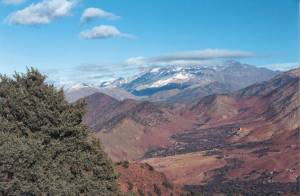 |
Clues:
1.This
pass is located in the highest part of a major intraplate mountain belt
named for a world-weighted Titan god. 2. The city to the northwest of the pass was immortalized in a song written by Graham Nash about a train of the same name. 3. Recent studies suggest that these mountains, composed of Jurassic rift sediments, accommodated a large percentage of a continent-continent plate collision that began in the Oligocene. Scroll down for the answer ... |
| Answer: The pass shown here is the Tizi'n Tichka Pass in the Atlas Mountains of Morrocco. Photo by Marcus E. Milling Jr. |
March 2001 winners:
Stephen Lenhart Radford, Va.
Sid Perkins Alexandria, Va.
Jim Sukup Carmel, Ind.
Sandra Stapp Oceanside, Calif.
Frank Swit Camp Hill, Penn.
Peter Soltys West Chester, Ohio
Mindi Snoparsky Philadelphia, Penn.
Jim Berg
Dan Cole Washington, D.C.
J. Brad Stephenson Oak Ridge, Tenn.
February 2001 clues & answer:
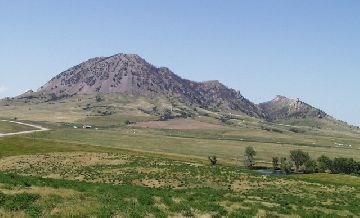 |
Clues:
1. This Tertiary-aged igneous intrusion is of a type first described by G.K. Gilbert in the Henry Mountains of Utah. 2. This lone mountain, sacred to the region's indigenous people, lies at one end of a linear belt of volcanic centers that continues westward to the alien landing site in the movie "Close Encounters of the Third Kind." 3. In 1876 at a nearby town, "Wild Bill" Hickok was shot and killed while playing poker. His hand - aces and eights, Jack of Diamonds high - is now known in poker parlance as the "Dead Man's Hand." Scroll down for the answer ... |
| Answer: Bear Butte, S.D. |
February 2001 winners:
Paul A. Hale - Pittsburgh, Penn.
Anne Wilson - Burton, Mich.
Peter Heitzmann - Woodbridge, Va.
Gretchen L. Hurley - Thermopolis, Wyo.
Jim Sukup - Carmel, Ind.
James McCombs - Kent, Ohio
Harry Filkorn - Kent, Ohio
Mike Dyre - Fairfax, Va.
Dawn Sukup - Bloomington, Ind.
Cheryl Frischkorn - Santa Fe, N.M.
January 2001 clues & answer:
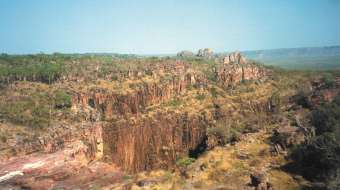 Laura Wright |
Clues: 1. The only nearby town of any size was named for an Englishman who explored this still sparsley populated region in 1839 while aboard a ship named after a breed of dog. 2. In the bottom left corner of this photograph, taken during the region's dry season, is the top of a waterfall that is one of the many that cascade from this 500-kilometer-long 1.6 billion-year-old quartz sandstone cliff. 3. The land shown here is a national park but not owned by the national government: It is leased from the native people who have inhabited the region for more than 40,000 years. Scroll down for the answer ... |
NAME THE CLIFF AND THE REGION AND COUNTRY
IN WHICH IT IS LOCATED.
| Answer: The cliff pictured here is the Arnhem Land Escarpment in the Northwest Territory of Australia. |
January 2001 winners:
Donald Brobst Virginia
Allyson Mathis Arizona
David Adilman Massachusetts
Cecile De Rouin Massachusetts
Mauri Pelto Massachusetts
John Elder Washington
Rob Viens Washington
Sandra Staff California
Christie O'Day Arizona
Jeff Ritchie Texas
December 2000 clues & answer:
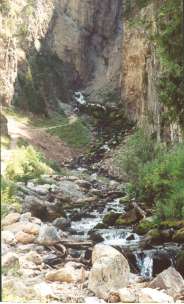 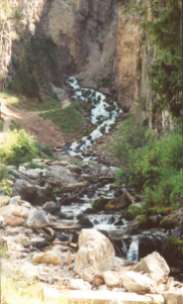 |
Clues:
1. These photos were taken within minutes of each other, illustrating a geologic oddity found in only two or three other places on Earth. 2. The spring, issuing from nearly vertical limestone beds, supplies drinking water for a nearby town in a valley named for an astronomical object. 3. The mountains to the north began forming 6 to 9 million years ago when a trap-door fault swung open. The fault's vertical displacement is estimated at 9,000 meters, and counting. Photos by Jim Sukup, Carmel, Ind. Scroll down for the answer ... |
| Answer: Periodic Spring, or Intermittent Spring, near Afton, Wyo. |
December 2000 winners:
Pete Folger Washington, D.C.
Doug Medville Reston, Va.
Ron Hallum Chula Vista, Calif.
Ron Pozun Warm Springs, Va.
Melody Holm Lakewood, Colo.
Chuck Weisenberg Lakewood, Colo.
Susan Landon
Stephen Lee Newbury, Calif.
Gretchen Hurley Thermopolis, Wyo.
Ray Petrun Soda Springs, Idaho
November 2000 clues & answer:
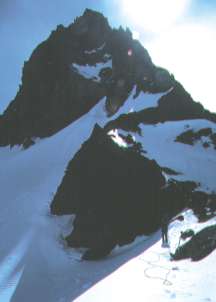 |
Clues:
1. Although under 2,500 meters high, this glacier-covered peak would make a chilly home for the gods. Areas of an adjacent rain forest receive an average of 167 inches of rain a year. 2. Rocks in this Cenozoic subduction comples range in age from 55 million years to 15 million years. 3. The first systematic exploration of the interior of this range took place in 1885. Scroll down for the answer ... |
| Answer: Mt. Olympus, Wash. Photo by Michael Svizzero. |
November 2000 winners:
Erin Sutton Leesburg, Va.
Joe Michaletz Helena, Mont.
Bruce Bryant
Tom Rinehart
Fred Hawkins Denver, Colo.
Mauri Pelto Dudley, Mass.
Paul Butler Olympia, Wash.
Stephen Lee Newbury Park, Calif.
Rob Viens Bellevue, Wash.
Gwyneth Jones Seattle, Wash.
October 2000 clues & answer:
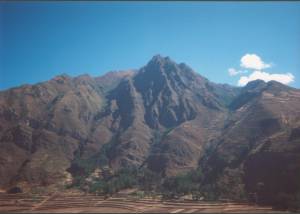 |
Clues:
1. An interannual climate phenomenon brought severe floods and landslides to this valley in 1998, claiming many lives and destroying a hydroelectric plant. 2. Within one 100-mile section of this mountain belt, the vertical distance between its high peaks and the bottom of the subduction trench offshore is as much as 14,000 meters (47,000 feet). 3. Tucked away in this mountain is an important archeaological site, one of many that dot the entire valley, which terminates at the remains of an ancient city forgotten until discovered by an archeologist in 1911. Scroll down for the answer ... |
| Answer: This mountain overlooks the colonial city of Pisac in south-central Peru's Urubamba valley, named for the river flowing through it. Also called the Sacred Valley, it was important to the Inca and houses many Inca ruins, including the ruins of Pisac, nestled behind this mountain, and the well-known city of Machu Picchu, which sits at the valley's northern end. Photo by Marcus E. Milling Sr. |
October 2000 winners:
George Dasher Elkview, WV
David King Auburn, Ala.
David Keating
Ryan Christiansen. DeKalb, Ill.
Paul Butler Olympia, Was.
Mauri Pelto Dudley, Mass.
Jim Humphrey Midland, Tex.
Michael Siemens Rolla, Mo.
Jeff Amato LasCruces, N.M.
Seigfried Hamann Huntington Beach, Calif.
September 2000 clues & answer:
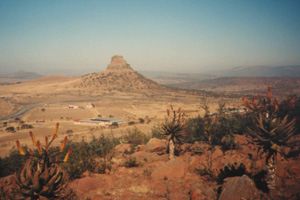 |
Clues:
1. The cap rock of the hill is a dolerite sill that formed during the breakup of Gondwanaland. The sill intruded sedimentary rocks that form the rest of the hill and surrounding plain. They belong to a lithologic group that contains this country's main source of coal. 2. In 1879, an indigenous army defeated British troops here in the first major battle of an eight-month war. 3. On Christmas Day in 1497, Portuguese explorer Vasco de Gama sighted the coast of the province in which this hill is located. This sighting inspired the province's name. Scroll down for the answer ... |
| Answer: Isandhlwana Hill in the Kwazulu Natal Province of South Africa. Isandhlwana Hill is a Karoo dolerite (Jurassic age) intrusive into Permian shales/sandstone of the Pietermariztburg and Vryheid Formations, Ecca Group, Karoo Supergroup. |
September 2000 winners:
John L. Snyder Arlington, Va.
William Smith McLean, Va.
George Dasher Elkview, WV
David T. King, Jr. Auburn, Ala.
David J. Wronkiewicz Rolla, Mo.
William M. Jordan Lancaster, Penn.
Bill Laughlin
Jesse Dann Cambridge, Mass.
Skip Blanchard
Dick Swainbank Alaska
August 2000 clues & answer:
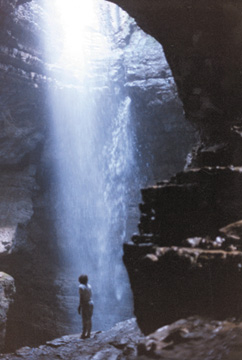 |
Clues:
1. This cave formed in Mississippian limestones that were themselves formed in an inland sea 300 million years ago. Its pit, the site of large waterfalls during wet weather, drops 142 feet from the surface and is a popular spot for rappelling. 2. Cherokee used nearby caves as a refuge from the elements. The caves show signs of intermittent human habitation for almost 10,000 years. 3. The cave is located in the northeast corner of a state that is home to the nation's premier society for the study, exploration and conservation of caves. Scroll down for the answer ... |
| Answer: Stevens Gap Cave in the northeastern corner of Alabama, in Jackson County. Photo provided by Gordon Brace. |
August 2000 winners:
Bill Torode Huntsville, Ala.
Jim Hall Madison, Ala.
George Dasher Elkview, W.V.
David Williamson Shreveport, La.
Billy Morris Rome, Ga.
James Currens Lexington, Ken.
Bill Balfour Blacksburg, Va.
Ray Yang Temple City, Calif.
Rob McDowell Atlanta, Ga.
Geary Schindel San Antonio, Texas
July 2000 clues & answer:
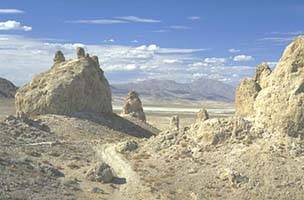 |
Clues:
1. These Pliocene-age formations were deposited along a fracture zone where calcium-enriched groundwater springs discharges in a series of lakes. 2. The name of this location includes an industrial mineral as does the name of a neighboring town. 3. Portions of Star Trek V were filmed here, and these deposits also appeared in artwork accompanying Pink Floyd's Wish You Were Here album. Scroll down for the answer ... |
| Answer: The answer is the Trona Pinnacles of the Pinnacles National Monument near Trona, Calif. Photo taken by John Karachewski. |
July 2000 winners:
Due to the large number of responses we received this month we accepted
only the most accurate responses despite the many close answers.
William Smith -- McLean, Va.
Lawrence Guth -- Fitchburg, Mass.
Jo Schaper -- Pacific, Mo.
Barry Knapp -- Lafayette, Colo.
John Whitaker -- Mo.
Elizabeth Kasehagen -- Santa Barbara, Calif.
Gloria Koroghlanian -- Phoenix, Ariz.
Joel Pederson -- Logan, Utah
Cheryl Martinez -- Tooele, Utah
Jeffrey Wilson -- Santa Monica, Calif.
June 2000 clues & answer:
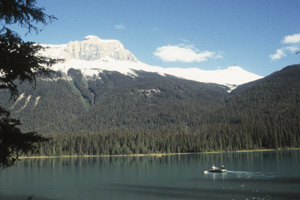 |
Clues:
1. More than half a billion years ago, this cliff was a reef, and the gem-like lake in the foreground would have been buried deep in muddy sediments. 2. The well-preserved remains of some wonderful animals were found at the base of the cliff in 1909. 3. Only a few years after that discovery, the area -- now a park -- served as a World War I internment camp for natives of the Austrio-Hungarian Empire. Scroll down for the answer ... |
| Answer: Emerald Lake and Mount Field, Yoho National Park, British Columbia, Canada. The Walcott Quarry, which contains the famous Cambrian fossil beds in the Burgess Shale, sits in the snow toward the right side of the photo. Photo from V. Collins Chew of Kingsport, Tenn. |
June 2000 winners:
Roger Borchert -- Bismarck, N.D.
Fred Hawkins -- Denver, Colo.
Toby Moore -- Irvine, Calif.
Ronnie Almero -- Irvine, Calif.
John Williams -- Sacramento, Calif.
Gisele Jakobs -- Berkeley, Calif.
Pamela Gore -- Clarkston, Ga.
Alan Fryar -- Lexington, Ky.
Curt Hudak -- Stillwater, Minn.
Leslie Gordon -- Menlo Park, Calif.
May 2000 clues & answer:
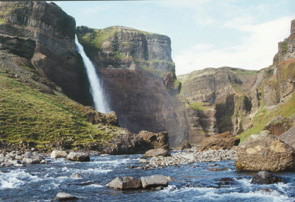
Christina Reed |
Clues:
1. Columnar joints, pictured top left, underlie large sections of this nation's landscape. 2. Hikers find this waterfall -- the second-tallest in the country at 120 meters -- near where "hell freezes over". 3. Jules Verne refers to this country's western peninsula in Journey to the Center of the Earth. Scroll down for the answer and winners ... |
| Answer: Haifoss waterfall is nestled west of Mount Hekla, the volcano known as the gate to hell in mediaeval Icelandic folklore, and south of the Langjokull glacier in Iceland. |
May 2000 winners:
Helen Delano -- York Springs, Penn.
Jesse Kasehagen -- Santa Barbara, Calif.
Honorable mention:
William Smith -- McLean, Va.
Katherine Price Blount -- Corpus Christi, Texas
Fred Hawkins -- Denver, Colo.
Nancy Williams -- Boulder, Colo.
Susan Banda -- Pamona, NJ
Mike Klein -- Boulder, Colo.
John Zeise
April 2000 clues & answer:
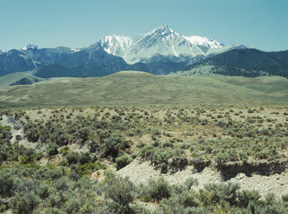
David Applegate |
Clues:
1.The fault scarp in the foregroung was formed in the last 20 years by a magnitude-7+ earthquake that killed two people in this sparsely populated region. 2. This 3,900-meter peak, composed of a Silurian and Devonian limestone sequence, is the highest in a range dominated by Mississippian carbonate banks. 3. Root vegetables are a staple of the inhabitants of the region, which was also a favorite haunt of the author of The Snows of Kilimanjaro. Scroll down for the answer and winners ... |
| Answer: Borah Peak is the highest point in Idaho, a state famous for its potatoes, and is the highest peak in the Lost River Range. It was the site of a magnitude-7.3 earthquake on Oct. 28, 1983 the largest ever recorded in Idaho. The quake produced extensive surface faulting and landslides. It caused two deaths and $12.5 million in damage in the Idaho towns of Challis and Mackay. |
April 2000 winners:
David Frank -- Washington, D.C.
Kate Johnson -- Reston, Va.
Roy Kepferle -- Cincinnati, Ohio
John Callahan -- Boone, N.C.
Fred Hawkins -- Denver, Colo.
Charlie Sandberg -- Lakewood, Colo.
Bill Lund -- Southern Utah University, Cedar City, Utah
Roger Smith --
Gloria Koroghlanian --
Joe Michaletz -- Helena, Mont.
2000: January February March April May June July August September October November December
2001: January February March April May June July August September October November December
2002: January February March April May June July August September October November December
2003: January February March April May June July August September October November December
2004: January February March April May June July August September October November December
2005: January February March April May June July August September October November December
2006: January February March April May June July August September October November December
2007: January February March April May June July August September October November December
2008: January February March April May June July August

 Subscribe
Subscribe

